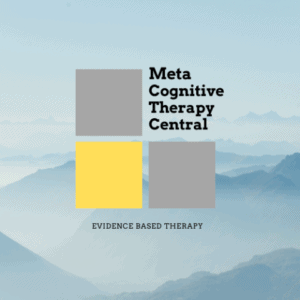
MCT therapists usually share similar experiences when it comes to treating clients with MCT. Here is a list of common questions that come up from clients, and the answers to them that can help you understand the process better.
MCT (Metacognitive therapy) is an evidence-based therapy that highlights excessive and uncontrollable worry and rumination as the cause of mental illness. MCT, therefore, focuses on reducing these thinking strategies, while reinforcing the belief that it is possible.
Question: Is it possible to get rid of negative thoughts?
Answer: No, you can’t get rid of negative thoughts.
Explanation: While we have some degree of control over what we think about (for example, you can bring up the thought chocolate in your mind(9)), we can’t fully control thoughts or make them disappear. If we try, we will spend a lot of mental effort without achieving the desired outcome.
The mind is built to produce negative thoughts, feelings, and impulses every day. They appear unconsciously from the experiences that you have, and are brief and harmless. In therapy, you can learn to control how you deal with them instead of overthinking them.
What to expect: It is normal to have all types of thoughts. Instead of pushing them away, try to reduce how much time you spend worrying and ruminating about them since too much worry and rumination reinforce negative thoughts.
Metacognitive therapy (MCT) recognizes that worry, rumination, and metacognitive beliefs about worry and rumination maintain psychological disorders. MCT was developed by British Psychologist professor Adrian Wells, the author of Attention and Emotion: A Clinical Perspective, which was awarded for significant contributions to psychology by the British Psychological Society.
Question: How can I solve problems if I don’t worry about them?
Answer: Worrying does not help solve problems.
Explanation: Worry reinforces a low and anxious mood, and it can cause anxiety(2). It is a mentally demanding process that clouds intuition and negatively impacts our problem-solving abilities. Instead of worrying, problem-solving should be used, as the name indicates, for solving problems. Compared to worrying, problem-solving is brief and effective. It helps you move forward and take action instead of worrying endlessly.
In fact, you don’t need to worry in order to solve everyday complex problems. Humans can solve multiple problems like working, driving, answering difficult questions, and making decisions without worrying(1).
Worrying is asking yourself what-if questions and imagining worst-case scenarios. The question, therefore, is, how will that help to solve problems?
What to expect: Learn that there are better ways to solve problems that do not include worrying. Identifying the problem, coming up with different solutions to the problem, and taking action are better ways to solve problems.
| Worrying | Problem-solving |
| I feel sick. What if it is something serious? Could be cancer? How will I cope?! I am too young to die from cancer and what about my children? How will they be able to make it? | I feel sick. It could be something serious, but I am not sure. I will call the doctor and schedule an appointment. In the meantime, I will stop speculating what it is because I don’t know. |
| What if I can’t stand the pressure at work? What if I do a terrible job and get fired? How will I cope? Can we afford the house? | Worrying does not help me cope right now. I will discuss this with my spouse later to prepare for financial worst-case scenarios. |
Question: My anxiety is overwhelming; why does it not go away?
Answer: If you are worrying and monitoring your anxiety, you end up sustaining it.
Explanation: Anxiety is a feeling that is automatically activated in the brain and sustained by excessive worry. Just like negative thoughts, you can’t control how you feel. Therefore, you can’t stop feeling anxious, but you can learn not to fuel anxiety through worry and other unhelpful strategies.
Worrying, monitoring the body, and suppressing and distracting yourself from anxiety are all part of the cognitive-attentional syndrome (CAS) that causes and maintains mental disorders.
What to expect: Anxiety is not harmful, and it doesn’t last if you leave it alone. The best thing to do is to acknowledge the anxiety and let your mind deal with it on its own.

Question: I don’t overthink much anymore, but why do I still feel down?
Answer: It sounds like you are monitoring your mood and expect a certain outcome.
Explanation: monitoring and analyzing how you feel is part of the CAS, and the CAS maintains emotional distress. There is a saying that watched water never boils. It is not possible to feel better when you comstantly think about how bad you feel.
Many people think that they have to wait for their mood to improve before they can enjoy their lives. However, waiting for certain feelings to go away is mentally draining and uses up resources that could be spent elsewhere; working, relaxing, learning new skills, and spending time with loved ones.
What to expect: It is possible to live a full life despite negative emotions. Focus your energy on creating a meaningful life without dwelling too much on how you feel.
Spending too much time monitoring your low mood will make you notice it more.
Question: How can I learn from past mistakes if I don’t ruminate?
Answer: Rumination won’t by itself help you act differently in the future.
Explanation: Rumination consists of asking yourself many “why”-questions. How many hours of asking “why” do you need to learn the lessons that need to be learned? It is possible to learn from past mistakes without hours of rumination. Lessons from the past can be learned quickly and effectively and then followed by appropriate action.
Five minutes of analysis can teach you the same lesson as five hours of rumination, without getting depressed.
What to expect: Understanding is good, but it does not by itself lead to solutions. Problem-solving and taking action are better strategies than ruminating for too long.
| Rumination | Taking action |
| That was stupid. Why did I say that? They probably think the worst about me. Maybe I offended someone with my comment. What if they don’t want to spend time with me anymore? I am useless… | Maybe they misunderstood my comments. Maybe not. I will check in with them the next time we talk. |
Question: Is leaving thoughts alone the same as suppressing them?
Answer: No, leaving a thought alone is not the same as thought suppression.
Explanation: Leaving thoughts alone instead of analyzing them or pushing them away is a strategy specific to MCT, called detached mindfulness. Wells developed detached mindfulness based on knowledge about the mind’s self-regulating ability (2).
The mind will regulate itself and let go of negative thoughts if you don’t attend to them.
Detached mindfulness is a “do nothing” strategy. Suppression, on the other hand, is doing something to thoughts and requires mental effort. Suppression is like using all your strength to keep a door closed, while detached mindfulness is letting go of holding the door.
What to expect: Suppression is an unhelpful and forced coping strategy that does not work long-term. It is important to learn detached mindfulness from a skilled MCT-I registered therapist, since many therapists confuse suppression with detached mindfulness.
You can read everything you need to know about detached mindfulness in this post.
People who suppress negative thoughts usually struggle to keep their thoughts away. Eventually, these thoughts come back and overwhelm them when they least expect it.
Question: A chemical imbalance causes my depression; will MCT help overcome depression?
Answer: Yes, MCT can successfully treat depression.
Explanation: Large studies show that over 70% recover from depression with MCT. According to the theory behind MCT(5) depression is caused by excessive rumination, and people can recover from depression once they reduce how much time they spend ruminating.
A recent study found no support for the hypothesis that depression is caused by a chemical imbalance in the brain (e.g., lowered serotonin activity)(6).
What to expect: Depression can be effectively treated with Metacognitive therapy, where unhelpful coping strategies like rumination and inactive and withdrawal behavior can be reduced (typical coping strategies of people with depression). 8-12 sessions are recommended.
For an in-depth explanation of MCT for depression, go to this post. To understand what rumination is and how to learn to reduce it, go to this post.

Question: Is MCT mindfulness?
Answer: MCT and mindfulness are not the same thing.
Explanation: MCT is built on a different theoretical foundation than mindfulness (which still doesn’t have a clear psychological theory that explains how it can treat mental illness). The goals are also different. Usually, people practice mindfulness to reduce discomfort, whereas MCT allows discomfort, but the goal is to leave it alone to let the mind self-regulate.
Mindfulness attempts to minimize discomfort by anchoring attention into the present moment. In comparison, MCT challenges metacognitive beliefs about thoughts to help reduce worry and rumination. (2) (3).
What to expect: The purpose of MCT is to help disengage from hours of rumination and worry because rumination and worry create mental illnesses like anxiety and depression. Mindfulness does not directly address rumination and worry or challenges metacognitive beliefs about thinking. If you suffer from a mental illness, your choice of therapy should be based on a clear scientifically explained theory and evidence that proves its effectiveness long-term.
If you like to learn more about the differences between mindfulness and MCT, read this post.
Summary
- Metacognitive therapy (MCT) is built on a theory about the mind’s natural ability to regulate thoughts. Excessive rumination and worry block this ability.
- MCT successfully helps to reduce rumination and worry through a strategy called detached mindfulness.
- Detached mindfulness is not the same as suppressing thoughts
- MCT is not the same as mindfulness; MCT is grounded in an evidence-based theory and does not require relaxation or body scan practices to reduce worry and rumination.
- Rumination and worry are not helpful strategies for solving problems. Problem-solving and taking action are better strategies.
- The goal of MCT is not to eliminate negative thoughts and feelings but to learn to leave them alone.

References
- Callesen, Live More Think Less: Overcoming Depression and Sadness with Metacognitive Therapy, ICON BOOKS, 2017
- Wells, Metacognitive Therapy for Anxiety and Depression, Guilford Press, 2008
- Fisher & Wells, Metacognitive Therapy Distinctive Features, Routledge, 2009
- Photo by Edwin Andrade
- Wells A (2019) Breaking the Cybernetic Code: Understanding and Treating the Human Metacognitive Control System to Enhance Mental Health. Front. Psychol. 10:2621. doi: 10.3389/fpsyg.2019.02621
- Moncrieff, J., Cooper, R.E., Stockmann, T. et al. The serotonin theory of depression: a systematic umbrella review of the evidence. Mol Psychiatry (2022). https://doi.org/10.1038/s41380-022-01661-0
- Photo by Adrian Swancar
- Photo by National cancer institute
- Wells, A., personal communication, 2022
